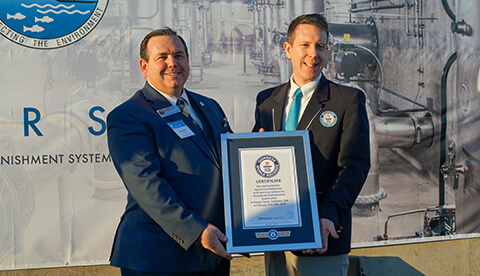What’s New In Municipal UV
The first TrojanUV open-channel UV systems were installed in the mid-1980s. By the 1990s, UV systems had become mainstream and were widely adopted for wastewater treatment. Since then, innovation in UV water treatment equipment and technology has continued, with revolutionary advancements along the way that have changed the way we think about UV.
Today’s newer systems offer significant energy, labor and maintenance savings, thanks to the latest in lamp technology, sleeve cleaning and controls/automation.
Improvements to UV Lamp Technology
Fewer lamps are needed to treat the same flow thanks to new technology that can pump out up to 1000 Watts per lamp. As lamps have become more powerful, they have also become more energy efficient, saving users up to 66% energy.
Improved controllers can help realize even more savings. For example, new controllers can automatically adjust lamp power during periods of low flow or changing water quality to conserve energy and extend lamp life, all while ensuring your required dose is being met.

Labor Savings
In new UV systems, there are up to 1/3rd fewer lamps to maintain and new controller and sleeve cleaning technology that can simplify an operator’s daily work. Smart controllers have expanded the capabilities available for monitoring and automating UV system functions, including diagnostics and alarms. Our ActiClean sleeve cleaning system saves hours of maintenance time by automatically cleaning quartz sleeves to prevent fouling.

Innovation to Installation
With over 10,000 municipal UV installations, we have many examples of UV innovation in action. One such example is in Chicago; The Metropolitan Water Reclamation District of Greater Chicago (MWRD) – of which the Terrence J. O’Brien Water Reclamation Plant (WRP) is part of – has made a number of upgrades to its treatment process over the years. The addition of UV inactivation was a critical part of these upgrades; it played a key role in improving water quality throughout the Chicago Area Waterway System (CAWS).
Featured Posts
La primera planta piloto de reutilización de agua potable en Europa utiliza Trojan UV AOP
Trojan se enorgullece de formar parte del proyecto de purificación de agua AIGUANEIX del Consorci d'Aigües Costa Brava Girona Trojan Technologies se complace en compartir que formamos parte del proyecto piloto de reutilización de agua AIGUANEIX de la Diputació de...
First Potable Reuse Demo Plant in Europe uses Trojan UV AOP
Trojan is proudly part of the Consorci d'Aigües Costa Brava Girona’s AIGUANEIX water purification project Trojan Technologies is excited to share that we’re part of Diputació de Girona and Consorci d'Aigües Costa Brava Girona’s AIGUANEIX water reuse pilot project at...
Trojan Technologies Opens First U.S. Distribution Facility in Grand Rapids, Michigan
On March 3, 2025, Trojan Technologies celebrated the grand opening of its first U.S. distribution center in Grand Rapids, Michigan. This strategic expansion underscores the company's dedication to enhancing customer experience and optimizing the delivery of its...







